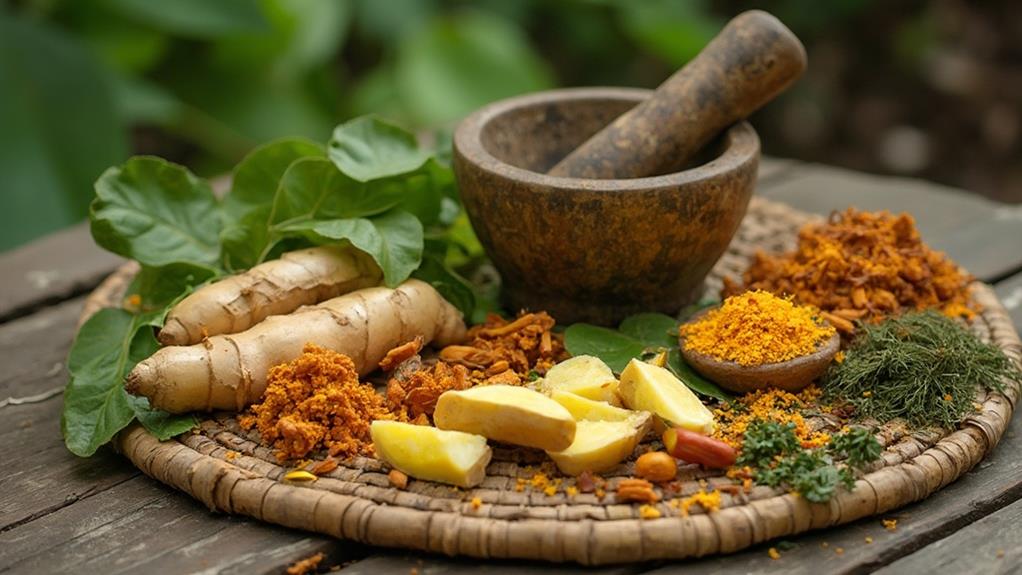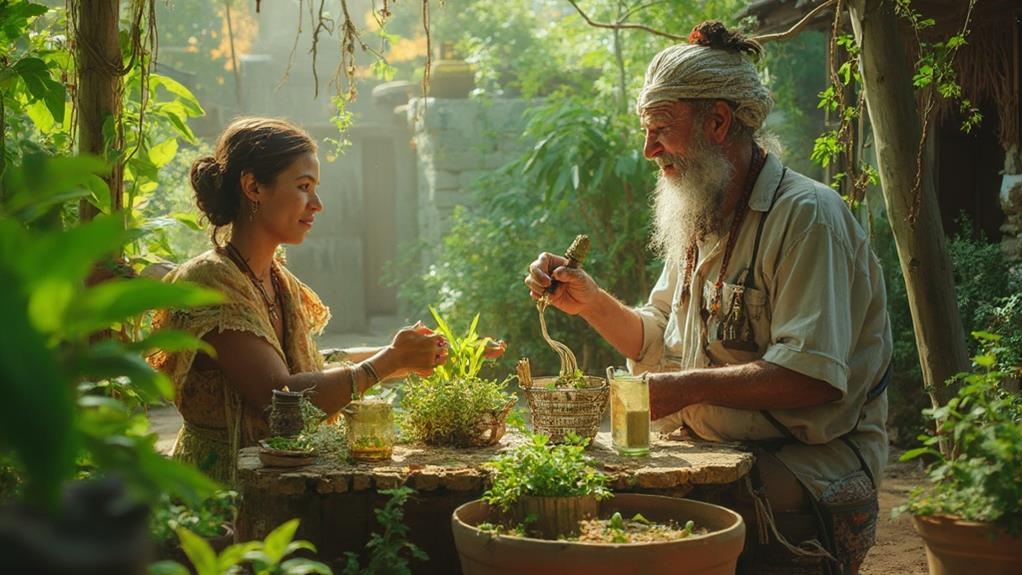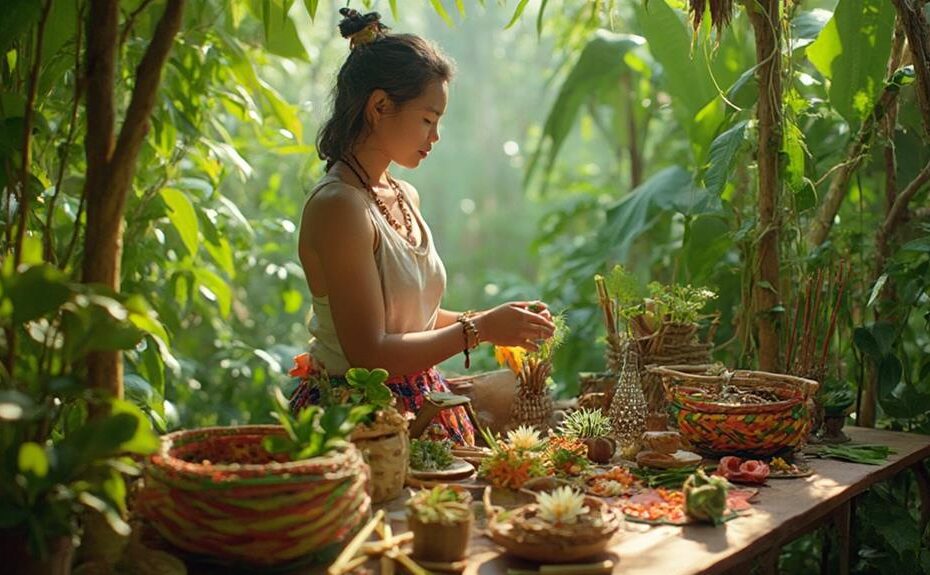Traditional Filipino medicine takes a holistic approach to health and wellness. This approach combines the use of herbal remedies, such as lagundi for coughs and sambong for fevers, with spiritual and ritualistic practices that promote balance and harmony.
Community healers, or albularyos, serve as trusted caregivers, integrating emotional and spiritual well-being into their care.
Traditional Filipino medicine draws upon centuries of indigenous knowledge, which is often passed down through generations.
As awareness grows, traditional practices are being embraced alongside modern healthcare for more comprehensive support. By combining these two approaches, individuals can receive more well-rounded care that addresses their physical, emotional, and spiritual needs.
Historical Context of Filipino Medicine
Filipino Medicine: A Rich Cultural Heritage
The roots of Filipino medicine date back centuries, shaped by the country's diverse cultural influences. Traditional healing practices have evolved from a blend of indigenous beliefs, Spanish influence, and Chinese medicine.
Early Filipinos relied on their extensive knowledge of local herbs, plants, and natural remedies to treat ailments. They passed down this wisdom through generations. For instance, tattoos played a significant role in traditional Filipino medicine, serving as markers of tribal identity and community belonging.
Community healers, known as "albularyos," played a crucial role in society. They were the primary figures for medical advice and treatment, utilizing a holistic approach that emphasized the balance between body, mind, and spirit.
This practice often involved rituals and spiritual elements, reflecting the deep connection to cultural beliefs.
During colonial times, Western medicine influenced Filipino practices, leading to a unique fusion of methods. Despite these changes, traditional medicine remained resilient, adapting and evolving with the times.
Today, there's a resurgence of interest in traditional Filipino medicine. It serves as a vital part of health and wellness, reminding us of the importance of heritage in healing practices.
Key Principles of Traditional Healing
Traditional Filipino healing prioritizes holistic well-being, recognizing that true health involves more than just the absence of illness. This approach emphasizes the interconnectedness of mind, body, and spirit. When assessing a person's state, traditional healers consider their overall well-being, rather than focusing solely on symptoms.
The balance of elements is a key principle, reflecting a deep understanding of nature. Healers believe that health is achieved when the body's energies—hot and cold, wet and dry—are in harmony. For example, a healer might diagnose an imbalance of hot energy and treat it with cooling remedies, such as herbal tea or a cooling bath.
Community and familial ties are essential, as traditional healing often involves collective support and shared practices. In many Filipino communities, family members and neighbors come together to provide emotional support and assist with healing rituals.
Intuitive knowledge passed down through generations is crucial, encompassing various techniques, such as massage, rituals, and dietary adjustments, aimed at restoring balance. This wisdom is often shared through oral traditions and hands-on training.
Spirituality plays a significant role, recognizing the importance of faith and belief in the healing process. Traditional Filipino medicine often incorporates spiritual practices, such as prayer and meditation, to promote healing and well-being.
Common Herbal Remedies Used

Traditional Filipino Herbal Remedies
Filipino medicine has a rich tradition of using herbal remedies, passed down through generations and shared among family members and communities.
Lagundi is a popular herb used to treat coughs and respiratory issues. Its effectiveness has made it a staple in many Filipino households.
Sambong, renowned for its diuretic properties, is often used to treat fever and flu-like symptoms.
Malunggay, also known as moringa, is packed with vitamins and minerals, making it an excellent supplement for overall wellness.
Bawang, or garlic, is celebrated for its ability to lower cholesterol and boost heart health.
For digestive concerns, peppermint, or yerba buena, can soothe upset stomachs and reduce bloating.
Luyang dilaw, or turmeric, is often used for its anti-inflammatory benefits.
These herbal remedies have been used for generations, offering natural and effective solutions for various health concerns.
Spiritual and Ritual Healing Practices
Spiritual and Ritual Healing Practices in Traditional Filipino Medicine
Balance and Harmony through Spiritual Practices
In traditional Filipino medicine, spiritual and ritual healing practices play a vital role in restoring health and wellness. These practices are rooted in the belief that physical health is closely tied to spiritual and emotional states.
Rituals are designed to restore balance and harmony within oneself, often involving the invocation of spirits or ancestors.
Filipino Tattoos as Spiritual Expression and Healing
Filipino tattoos, for instance, serve as markers of tribal identity and community belonging, reflecting a rich cultural tapestry that binds communities together.
They can also be seen as a form of spiritual expression and healing. Traditional tattooing practices are considered sacred rituals, passed down through generations, with origins intertwined with Filipino traditions and beliefs.
Diagnosing Ailments through Rituals
One common practice is the "pagtatawas," a ritual where a healer uses a candle and a basin of water to diagnose ailments. This process helps identify spiritual disturbances affecting one's health.
Similarly, "hilot" involves massage techniques that relieve physical pain and align one's energy.
Ceremonies for Healing and Community
You may find ceremonies, like "babaylan," where a spiritual leader performs prayers, chants, and offerings to promote healing.
These rituals foster a sense of community and connection, reinforcing the idea that healing isn't just an individual journey but a collective experience.
The Role of Community Healers

Community healers play a vital role in traditional Filipino medicine, serving as both caregivers and cultural custodians. They possess a deep understanding of herbal remedies, spiritual practices, and local healing traditions passed down through generations.
For example, they often draw inspiration from the rich cultural tapestry of Filipino tattoos, which serve as markers of tribal identity and community belonging.
These healers assess your condition holistically, considering not just physical symptoms but also emotional and spiritual well-being. They blend their knowledge of nature with a keen intuition, allowing them to address various ailments effectively.
By considering the whole person, not just the illness, they provide a more comprehensive approach to healing.
In many communities, these healers are trusted figures, often consulted before turning to conventional medical options. Their presence fosters a sense of belonging, as they connect individuals to their heritage while providing valuable health services.
For instance, their communal practices encourage open dialogue about health and wellness, strengthening community ties.
Integration With Modern Healthcare
Integrating traditional Filipino medicine with modern healthcare can create a more holistic approach to well-being. This integration allows individuals to benefit from the strengths of both systems, enhancing overall health outcomes.
Traditional practices, such as herbal remedies, massage, and spiritual healing, often emphasize prevention and community involvement, aligning well with modern medicine's focus on evidence-based treatments.
Preserving traditional craftsmanship can contribute to community cohesion and pride, positively impacting mental health and well-being. For example, traditional Filipino weaving and pottery-making can bring communities together, fostering a sense of pride and belonging.
This, in turn, can positively impact mental health and overall well-being.
Combining traditional and modern approaches can address physical, emotional, and spiritual aspects of health. While undergoing conventional treatments for a condition, individuals can also explore traditional remedies that provide relief and comfort.
For instance, patients with anxiety may find that traditional Filipino meditation practices, such as "meditasyon," complement their conventional therapy.
Healthcare providers are increasingly open to collaboration with local healers, leading to more personalized care. This partnership respects cultural beliefs while ensuring individuals receive effective medical treatment.
Local healers can provide valuable insights into traditional remedies, and healthcare providers can offer evidence-based guidance on their safe and effective use.
Benefits of Holistic Approaches

Holistic approaches to health and wellness focus on treating the whole person—body, mind, and spirit—rather than just addressing specific symptoms. This comprehensive view allows for a deeper understanding of one's health, enabling a stronger connection between emotional and physical aspects.
Holistic approaches incorporate natural remedies, lifestyle changes, and preventive measures to promote overall well-being. For example, practices like meditation, herbal medicine, or acupuncture can reduce stress and anxiety, enhancing the body's natural healing processes and promoting balance.
By prioritizing self-care and mindfulness, individuals can cultivate better habits that lead to long-term wellness. This active role in one's health journey empowers individuals to take charge of their well-being, enriching their lives in various meaningful ways.
Holistic approaches also foster a sense of community, as many involve group activities, workshops, or sharing knowledge with others. This collective approach can lead to a stronger support system, encouraging individuals to continue their path towards overall wellness.
How Does Sinigang and Other Traditional Filipino Medicines Contribute to Overall Health and Wellness?
Sinigang, a traditional Filipino soup, is not only a delicious dish but also comes with sinigang health benefits packed vitamins minerals. Many other traditional Filipino medicines, such as herbal teas and infusions, contribute to overall health and wellness. These natural remedies have been passed down for generations and are known for their healing properties.
Challenges Facing Traditional Practices
Challenges Facing Traditional Practices
Lack of Scientific Validation
Traditional practices often struggle to gain acceptance due to the lack of scientific validation. Many traditional remedies haven't undergone rigorous research, making it difficult for practitioners and patients to trust their efficacy.
For instance, some people are skeptical and prefer Western medicine, which prioritizes evidence-based treatments. This lack of validation hinders the adoption of traditional practices, such as traditional tattoos, which are often overlooked in favor of modernization.
Decline of Traditional Knowledge
The decline of traditional practices is also attributed to the diminishing knowledge among younger generations. As modern lifestyles take precedence, traditional healing methods are often overlooked or forgotten.
This gap can lead to a loss of cultural heritage and the valuable wisdom that comes with it. For example, traditional tattooing practices have declined due to Spanish colonization, which has led to the loss of cultural heritage in indigenous communities.
Regulatory Issues
Regulatory issues create barriers for traditional practitioners. In many cases, traditional practitioners aren't recognized or licensed, which limits their ability to practice legally.
Additionally, competition with pharmaceutical companies often overshadows traditional remedies, as advertising and marketing favor conventional medicine.
This imbalance hinders the adoption of traditional practices and limits access to alternative healthcare options.
Case Studies and Success Stories

Traditional Filipino Medicine Enhances Modern Health and Wellness
In the Philippines, numerous case studies demonstrate the successful integration of traditional Filipino medicine into modern health and wellness practices.
The use of herbal remedies like lagundi for treating coughs and respiratory issues is a notable example. Patients often report significant relief when combining it with conventional treatments, showcasing how these natural solutions can complement modern medicine.
Filipino Tattoo Art and Cultural Significance
The cultural significance of tattoos in Filipino identity is reflected in the use of traditional tattoo designs that convey strength, protection, and spiritual significance.
These designs can be applied to modern wellness practices, enhancing their cultural relevance and significance.
Revival of Hilot: A Traditional Filipino Massage Technique
The revival of hilot, a traditional Filipino massage technique, is another inspiring case.
Many wellness centers now incorporate hilot into their services, promoting relaxation and pain relief. Clients remark on the benefits of combining this ancient practice with modern physiotherapy, leading to improved recovery outcomes.
Collaboration between Traditional Healers and Modern Healthcare
In rural areas, traditional healers, or manghihilot, have partnered with local health facilities to provide holistic care.
These collaborations have resulted in better patient satisfaction and reduced healthcare costs, proving that traditional practices can coexist with modern healthcare.
Future of Traditional Medicine in the Philippines
The future of traditional medicine in the Philippines looks promising as communities increasingly recognize its value alongside modern healthcare. This growing recognition is driven by the desire for holistic wellness, which is achieved by combining traditional practices with contemporary treatments.
For instance, the preservation of traditional Filipino tattoo art highlights the cultural significance of traditional medicine in the country's identity, leading to increased adoption.
Local governments and health organizations are integrating traditional medicine into public health initiatives. This integration is expected to lead to more educational programs promoting the benefits of herbal remedies and local healing practices.
These programs will empower individuals and communities to take charge of their health with a broader range of options.
Researchers are exploring the scientific basis of traditional healing, which may provide more robust evidence supporting its efficacy. This research can bridge the gap between traditional and modern medicine.
Furthermore, the rise of telemedicine will expand access to traditional practitioners, making it easier for individuals to consult with experts from the comfort of their homes.
